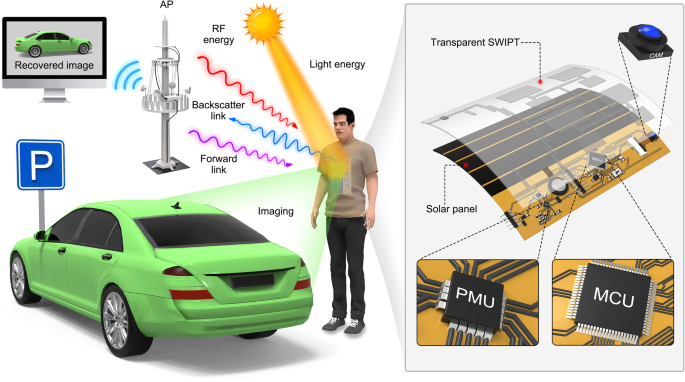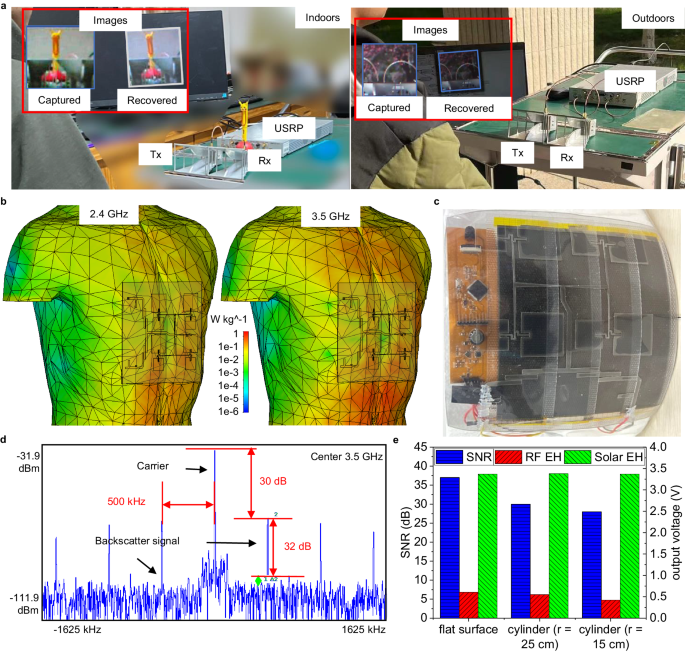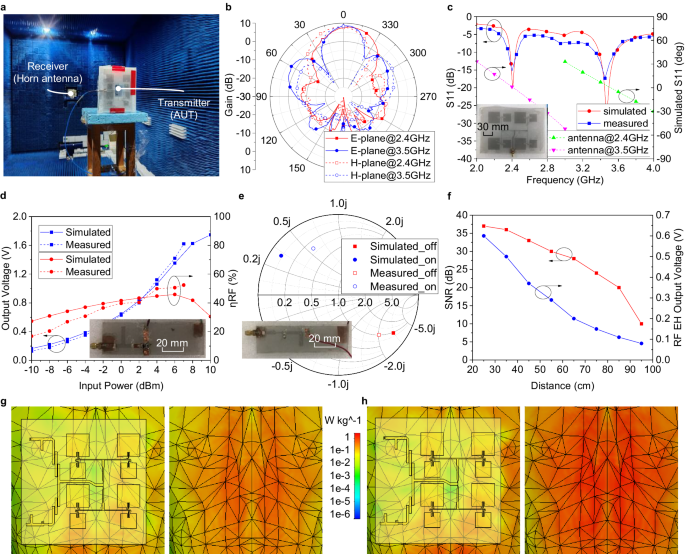
【Summary】
Wireless imaging technology, equipped with ultra-low-power wireless communication and energy harvesting capabilities, has become a battery-free and sustainable solution. However, challenges remain in achieving wireless color imaging in wearable applications, primarily due to high power consumption requirements and the need to balance energy harvesting with device compactness. Recently, Professor Lu Weibing of Southeast University designed a flexible wearable battery-free backscatter communication system specifically for color imaging. This system employs a hybrid radio frequency and solar energy harvesting array, efficiently harvesting energy from both radio frequency and visible light sources in the environment, ensuring continuous operation in various environments. Secondly, flexible materials allow the system to adapt to the human body, ensuring comfort, user-friendliness, and safety. Furthermore, a shared aperture antenna array for simultaneous wireless information and energy transmission, combined with an optically transparent stacked structure, achieves a compact design. This design not only optimizes space utilization but also maintains the performance of both communication and energy harvesting processes. The proposed flexible wearable color imaging system holds promise for applications in environmental monitoring, target detection, and law enforcement recording. This approach demonstrates a sustainable and practical solution for next-generation wearable devices with high power consumption requirements.
【Research Background】
Backscatter communication, renowned for its low power consumption and low cost, plays a crucial role in IoT systems. Imaging technology is essential in applications such as environmental monitoring, target detection, and law enforcement, and the combination of backscatter communication and energy harvesting has driven the development of battery-free wireless grayscale imaging solutions. However, achieving wireless color imaging in wearable devices presents challenges. Compared to grayscale imaging, the main issue is the higher power requirements of color imaging, which complicates balancing power density and the compactness required for wearable applications.
In wearable battery-free applications, radio frequency (RF), ambient light, thermoelectric, and biomechanical energy sources are increasingly sought after. While hybrid RF and solar energy can improve the amount of energy harvested, their tight integration with backscattered communication (SWIPT) presents challenges for wearable applications. By using a transparent stacked hybrid RF and solar energy harvesting system, simultaneous utilization of both energy sources can be achieved within a compact area. Furthermore, a common-aperture design allows antennas operating at different frequencies to coexist in a compact space, optimizing space utilization and enabling compact wireless powered communication ( SWIPT ).
Recently, Professor Lu Weibing of Southeast University proposed a flexible wearable battery-free backscatter wireless communication system specifically designed for color imaging. This system employs a hybrid RF and solar energy harvesting array to efficiently harvest energy from environmental RF signals and visible light. By using flexible conductors and substrates, the system can conform to the human body, ensuring comfort, user-friendliness, and safety while reducing specific absorptivity ( SAR ). Since the system's modulation state has minimal impact on its radar cross section ( RCS ), it exhibits stable wearable communication performance. Furthermore, a compact form is achieved through frequency division multiplexing (FDM) technology and a transparent stacked hybrid RF and solar energy harvesting array. A common-aperture antenna array enables simultaneous operation of RF energy harvesting and backscatter communication, effectively reducing interference between the two operations. The transparent stacked structure not only maintains the efficiency of both RF and solar energy harvesting but also ensures that the performance of the RF components is unaffected by the solar cells. The adopted strategy addresses key challenges in energy harvesting and powered communication in the wearable field, demonstrating a sustainable and practical solution for next-generation wearables and high-power-demand devices. This work was recently published in the journal npj Flexible Electronics.
【Illustrated Explanation】

Figure 1 shows a compact, flexible, battery-free backscatter communication system applied to wireless color image transmission. It includes a transparent SWIPT , a flexible solar cell, a power management module ( PMU ), a microprocessor ( MCU ), and a color camera ( CAM ). The system is worn on the chest and collects radio frequency and light energy. When it approaches a wireless access point ( AP ), it takes a picture and transmits it back to the AP using backscatter communication.

Figure 2 Performance of the flexible battery-free backscatter communication system. a. Indoor and outdoor wireless image transmission tests. b. SAR simulation of backscatter communication and wireless energy harvesting . c. Photograph of the system conformally mounted on a cylinder with a radius of 15 cm . d. Backscatter communication spectrum. e. Performance of communication and energy harvesting under different bending conditions.
A flexible, battery-free communication system. The system employs a stacked structure, with transparent frequency division multiplexing (SWIPT) devices placed on flexible solar panels and flexible circuit boards, ensuring the normal operation of both the solar panels and the CAM (Computer Integrated Circuit ). In outdoor or indoor scenarios, when the hybrid RF and solar energy harvesting array obtains sufficient power from wireless signals or sunlight, the CAM captures color images , which are then encoded by the MCU (Microcontroller Unit). The MCU controls the modulator in the SWIPT device for backscatter communication. This system achieves a communication rate of 500 kbps at a distance of 25 cm from the USRP (United States Resonant Power Regulator) device , with a SAR ( Specific Absorption Rate) of less than 0.66 W kg⁻¹ .

Figure 3. Performance of the transparent frequency division multiplexing (SWIPT) device. a. Far-field test scenario of the common aperture antenna array. b . Antenna pattern. c . Antenna S11 . d. Output voltage and rectification efficiency of the RF rectifier circuit. e. S -parameters of the modulator under different states . f. The impact of the distance between the system and the USRP device on its RF energy harvesting and wireless communication performance. g . The impact of wearable SWIPT devices on human SAR at 2.4 GHz . h. The impact of wearable SWIPT devices on human SAR at 3.5 GHz.
A transparent frequency division multiplexing (FDM) SWIPT device. The antenna array employs a common-aperture design to achieve RF energy harvesting and backscatter communication at 2.4 GHz and 3.5 GHz , respectively , with corresponding gains of 7.7 dBi and 8.4 dBi . The modulator uses a PIN diode to implement BPSK modulation with a modulation coefficient of 0.45 . The modulator state has almost no effect on the device's RCS . For RF energy inputs from -10 dBm to 10 dBm , the rectifier can achieve a voltage output of 0.17 V to 1.7 V , with corresponding rectification efficiencies between 27% and 46% . Placing the device on a human body surface shows almost no change in the device's RCS , while the SAR of the human body surface is significantly reduced.

Figure 4. Hybrid RF and solar energy harvesting array. a. Schematic diagram. b. RF energy harvesting test scenario. c. Output voltage of the hybrid energy harvesting array and PMU under different illumination and RF intensities . d. Influence of different illumination and electromagnetic wave incident angles on energy harvesting performance.
Hybrid RF and solar energy harvesting array. The solar cell array and rectifier antenna array are connected in series for output. The hybrid energy output level and light intensity are related to the equivalent isotropic radiated power ( EIRP ), while the PMU provides energy storage and stable output. The PMU can operate normally when the light intensity is greater than 13 lux , or when the EIRP of a USRP device 25 cm away from the system exceeds 27 dBm . The performance of the hybrid energy harvesting array is related to the incident angle.
【Summary】
This paper develops and demonstrates a flexible, wearable, battery-free backscattered wireless communication system. Energy is efficiently harvested from environmental radio frequency signals and visible light by integrating a hybrid radio frequency and solar energy harvesting array. The system's stability under different bending conditions and its interaction with the human body are evaluated through simulation and experiments. A balance between energy harvesting, wireless communication, and device compactness is achieved through a stacked common-aperture design. This system demonstrates its potential for wireless color image transmission.
【Journal Introduction】npj Flexible Electronics, launched in 2016 by Nanjing University of Technology in collaboration with Nature Publishing Group, a subsidiary of Springer Nature, is the first "Nature Partner Journal" (NPJ) in the field of flexible electronics. It reports on flexible electronic materials, devices, systems, and integration. In June 2021, it received its first impact factor of 12.740.
Publisher:
NATURE PORTFOLIO, HEIDELBERGER PLATZ 3, BERLIN, Germany, 14197
ISSN / eISSN: 2397-4621
Issues Per Year: 1
Web of Science Core Collection:
Science Citation Index Expanded (SCIE)
Journal Website:
https://www.nature.com/npjflexelectron/
npj Flexible Electronics ranks 6th out of 275 SCIE journals in the JCR quartile of Engineering, Electrical & Electrical Sciences (Q1); and 27th out of 342 SCIE journals in the MATERIALS SCIENCE, Multidisciplinary Sciences (Q1).
In the rankings by the Chinese Academy of Sciences, npj Flexible Electronics is classified as follows: Materials Science (Q1); Materials Science, Multidisciplinary (Q1); Engineering, Electrical & Electronic (Q1).
The journal is edited by Academician Huang Wei , Dean and Academic Leader of the Institute of Advanced Materials, Chinese Academy of Sciences, and Professor Wang Jianpu, Executive Vice Dean (at the level of Director General) of the Institute of Advanced Materials, serving as Executive Deputy Editor-in-Chief. More than 20 world-class scientists from the United States, the United Kingdom, Germany, Italy, Switzerland, the Netherlands, Australia, and Singapore, including Academician Huang Yonggang of the National Academy of Sciences and the National Academy of Engineering of the United States, Academician Bao Zhenan of the National Academy of Sciences and the National Academy of Engineering of the United States, and Academician Paul Burn of the Australian Academy of Science, serve on the editorial board.
npj Flexible Electronics publishes high-quality articles related to flexible electronic systems, including plastic electronics and emerging materials, new device design, manufacturing technologies, and applications.
As the leading journal in the field of flexible electronics, npj Flexible Electronics has established a forward-looking international high-end sharing and exchange platform in the fields of flexible electronics and materials science, electronic information, and life and health, emphasizing article quality and building a brand image.
Jun-Lin Zhan et al. Flexible and wearable battery-free backscatter wireless communication system for colour imaging.
npj Flexible Electronics 2024, 8, 19
Original link: https://www.nature.com/articles/s41528-024-00304-4



 京公网安备 11010802027423号
京公网安备 11010802027423号